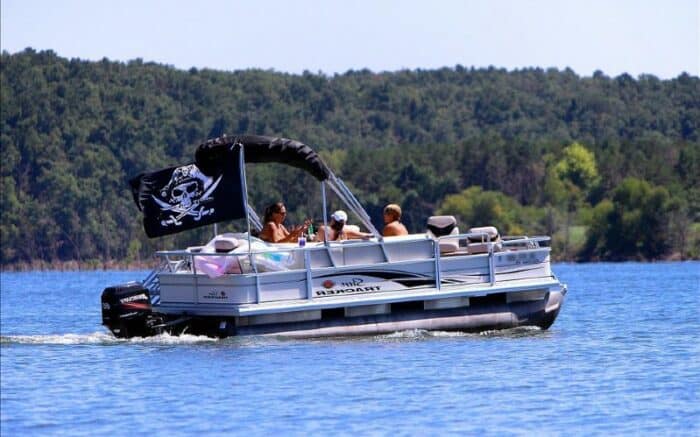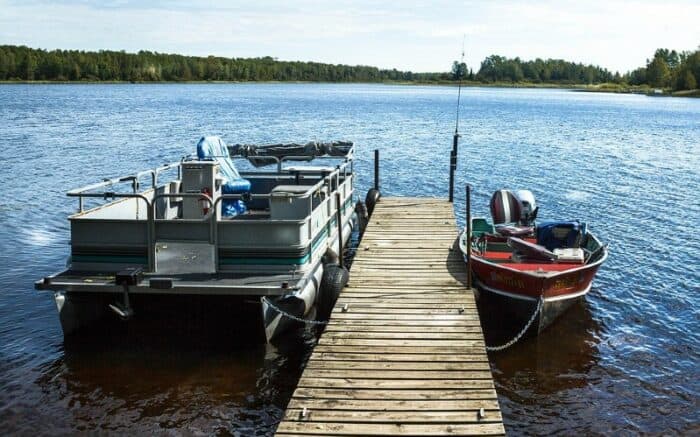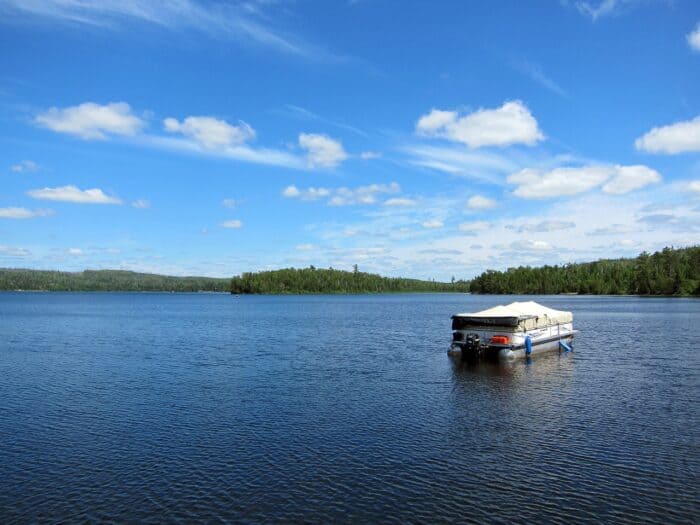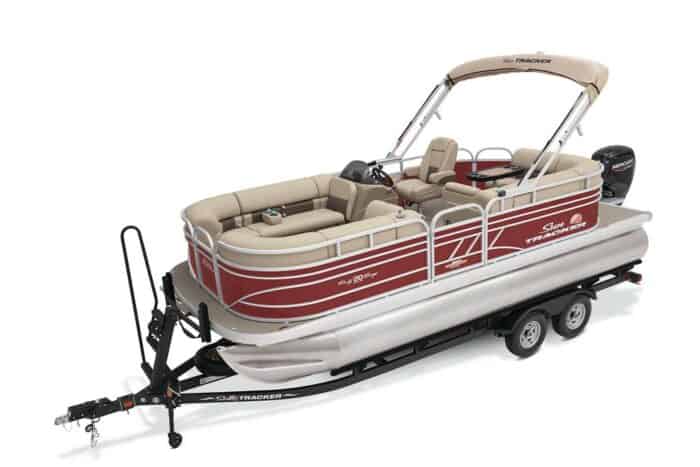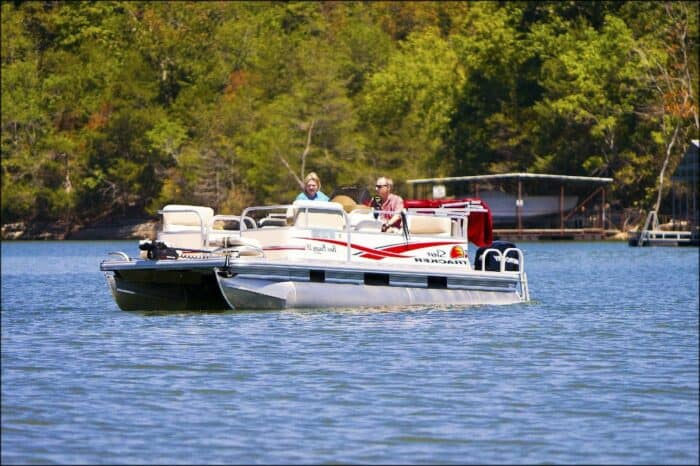How to Drive a Pontoon Boat
Pontoon boats tend to be very easy to drive compared to some other boats out there. Maybe that’s why they are enjoying a surge in popularity these days in the boating world. They offer a lot of perks at a pretty reasonable price overall. But just because they’re relatively easy to manage doesn’t mean there’s nothing to learn or understand about driving one. There’s definitely a learning curve if you’re new to driving a pontoon boat. Let’s take a look at some of the basics about what a pontoon boat is and then how to best handle it once you’re out on the water.
Pontoon Boats: Easy Driving in 9 Simple Steps
Okay, so let’s get to the meat of it. You want to know how to drive a pontoon boat. As in any boating situation, you’re going to want to make sure you’re being safe before you even start the engines up. If you’re in unfamiliar waters, remember to take things slow and steady and be cautious. If you don’t know currents and shallows, potential hazards and so on, don’t take any risks.
Make sure everyone has their life jacket on. Double check your fuel tank as well if you didn’t just fuel up. Also check your radio to make sure it’s working.
Secure anything you’ve brought on board with you like a cooler or gear like fishing rods, deck ropes and such. Have a crew member secure things with bungee cords if necessary.
If you’re confident you have all the safety gear you need on board and are ready to go, then it’s time to take your pontoon boat out.
Step 1: Turn your motor on. Once the battery is switched on, take a seat in the captain’s chair and attach your emergency stop lanyard. Make sure the emergency stop switch is set to RUN. Don’t forget to trim your motor down if you don’t have it submerged in the water. If it’s all in position, turn the key and start the motor.
You’re going to want to let the motor warm up for a minute or two before you do anything. If it doesn’t start at first and you already know your fuel levels are okay, make sure you have the boat in neutral.
Step 2: Double check. Keep your motor trimmed to the right level. You want those props just submerged in the water, but not too deep. Now you can check your gauges and make sure everything looks good. Fuel and battery voltage should always be double checked before heading out.
Step 3: Untie the lines. If you have a crew, they can handle the job of untying the deck ropes. If it’s just you, make sure you’re not attached to the emergency lanyard when you go to loose the lines.
Step 4: Heading out. Once you’re free of lines, it’s time to ease out of the slip or dock. This will obviously depend on how you’re docked in the first place, what position you’re in, and the relative position of the dock or other boats. Slow and steady is the name of the game here. I said pontoon boats weren’t speed demons early, but they can still get a good pace. You never want to leave the dock all fast and furious, though. Gentle on the throttle and use just enough power to move forward slowly until you’re free and clear. Accelerate with controlled bursts so you don’t lose control.
Step 5: Maneuvering. Out of the dock, you just need to get yourself headed in the direction you plan to go. The steering on a pontoon boat is pretty simple and not all that different from driving a car. You just need to remember that a turn, especially a fast turn, can make you overshoot your goal by a lot if you’re not careful. It takes some practice to get a feel for the right mix of throttle and steering. This can also depend on the size of your pontoon boat and the power of your motor. If you’re new to the boat, you may want to practice a bit of maneuvering before you do much else. Get a sense for the throttle you need to move forward and in reverse. Then try your hand at changing directions, turning around fully, heading into the wind, and so on.
Turning in a pontoon boat is not a subtle process. These aren’t turn on a dime vessels at all, so you’ll need to get used to those wide arcs. If you try to make a sharp turn, what happens is the front of the boat will lean into it while the rear will whip to the side as it keeps trying to go the same direction you were just headed. If you have passengers they’re going to become pinballs. You need to announce any sharp turns ahead of time if you must make them. That allows everyone to brace themselves and distribute weight evenly. Good weight distribution can make a sharp turn a lot more gentle. So you need to handle turns with some finesse, avoid sudden turns, and take them slow and steady.
If you find yourself turning into the wind you’re going to have an awkward time of it. Wind and pontoon boats don’t get along when they’re at odds. You’ll want to position the boat downwind as much as you can to make things easier on yourself, and reduce speed for any turns when you’re fighting the wind.
Step 6: Cruising. Once you’re confident you can handle the boat, you can get it up to cruising speed. If you’re new to boating or this specific pontoon boat, you’ll want to proceed with a little caution here. Everyone loves opening the engine up and tearing up the water, but you need to build up to that. Learn the ropes first, as it were.
Ease the throttle up to speed instead of just slamming on it. It’s good to get a sense of how the boat builds speed so you can understand how to work that throttle. In general you’ll probably want to keep your boat running at around 4,000 to 4,500 RPMs. This won’t break speed records but, again, you’re in a pontoon boat. It will ensure you don’t burn through a ton of fuel and also ensure you can have ideal control of the boat.
Step 7: Stopping. Just like maneuvering, you’ll want to get a feel for how to stop your pontoon boat. Throttling back into reverse and getting the boat to slow and ultimately stop takes a bit of finesse. The process is basically the same from boat to boat, but each one tends to have its own feel. So even if you’re an old hand at this, you should know that it may take a bit of getting used to in a new boat. It’s worth trying it out so you know how much or how little throttle is needed and how the boat handles it.
Step 8: Trimming the motor. So you’re out on the water now and you understand the basics of maneuvering and cruising. Now’s when you can truly drive the boat and get down to it. That’s going to involve trimming the engine some more. Trimming the engine is a term that just refers to the position of the propellers in the water. You trim an engine up by raising the props. If your motor is trimmed all the way up then you’ve pulled the propeller fully out of the water. Trimmed down and it’s as deep as you can get it. Neither one of these is particularly advantageous to optimal operation of your boat, mind you. Learning how to trim the motor exactly right will greatly improve your speed and control.
You want to learn how to trim the engine in deeper water. There’s a risk of hitting bottom or, at the very least, plants and debris, in shallower water. You don’t want that. But if you know how to trim the motor, you can still travel shallow waters because you’ll understand how to keep it up safely.
If you’re looking to hit some speed and go faster in deep water, you’ll be trimming the motor down. Your throttle should have trim controls on it. A button with a series of trim numbers lets you trim up to higher numbers and down to lower numbers. So you’d set it to a low number in deep water as you’re cruising to keep the bow up as you travel.
When you hit shallower water you need to trim up to avoid damage. Like anything else, learning the trim takes a bit of time. You develop a feel for it. The way the boat handles, even the sound of it, changes as the trim changes. You’ll see what allows for better handling and speed and learn what works best. This can change not just with water depth but with current and wind speed as well. For those reasons you always want to have one hand on the steering wheel and one on the throttle so you can make small adjustments moment to moment as necessary.
Step 9: Docking. Once you’ve figured out how to handle the boat, how to throttle, slow, stop and trim the engine, you’re pretty much good to go. When you head back to the dock you’re just going to need to reverse the process that got you out in the first place. That means keeping your speed slow so you can maximize your maneuverability and response time as you head into dock.
Make sure you’re paying attention to posted speed limits and follow them accordingly. When it comes to getting the pontoon boat into dock, try not to feel pressure if it’s not working out at first. It can get stressful if you’re trying to back into a slip or line up exactly along the dock when there are other boats waiting. If it takes you more than one try, that’s better than trying to force it and potentially damaging your boat, the dock, or someone else’s boat.
Approach the dock slowly and shift to neutral before you reach your target. Let the boat’s momentum help you coast into the position you want to be in. Because of how pontoon boats float on the water, this can feel a little different than it might with a different style of boat. If you’re not used to it it can be a surprise, so this is a great time to develop an understanding of how a pontoon boat coasts when it’s in neutral as well as when and when you want to make these adjustments.
Again, how you dock depends on the dock itself, if you’re sidling up to the dock, reversing into a slip, and so on. Once you’ve adjusted into the position you need to be in, have one of your passengers get on the dock to secure the lines in place.
Things to Watch Out For
Wind and current: A pontoon boat rides on top of the water and that means it’s subject to outside forces pushing it around. Current and wind can play havoc with your pontoon boat if you’re out during a rough day. If it’s a really windy or choppy day, or you find yourself in a strong current, you’re going to lose a lot of maneuverability. If that happens, make sure you don’t panic and be aware of how the boat is responding. You’ll probably need to up the power from the motor to regain some control and make many more fine adjustments to your maneuvering as a result.
Hazards: Pontoon boats are built pretty tough but you never want to take unnecessary risks. In addition to making sure you’re watching your trim in shallow water, always be aware of the conditions around you. Keep your eyes 100 feet ahead of the boat when you’re in motion and give yourself room to maneuver if you see anything like a submerged tree, a sandbar, or anything that could cause you to run aground. You never want to risk damage to the pontoons themselves.
Driving Pontoon Boats vs Other Boats
If you have never been behind the wheel of a boat before, then you may not see where this strays from the normal path. I would say a pontoon boat is, for the most part, easier to handle than a lot of other boats. Driving it is maybe more of a laid back experience, you could say. Because of the size, shape and design of pontoon boats, you’ll find yourself moving slower, as we mentioned earlier. They maneuvering feels a little clumsier than it might in something like a ski boat, also. A lot of people want to compare driving a boat to driving a car but it’s a hard metaphor. Remember, on water, you’re not stopping on a dime or demonstrating that level of control. So when you get a feel for how to drive a few different kids of boats, then you’ll really appreciate how different driving a pontoon boat is.
A lot of the difference comes from that drifting you’re going to experience as a result of the pontoons themselves. That’s part of the reason you need to make those really wide turns. It’s also why sharp turns are harder. If you have a sail boat with a large keep in the water, the force of the water itself is helping to stabilize the boat. And even then, if you take a sharp turn at high speeds, the crew all need to move on the boat to help ensure everything stays upright and no one is being knocked around.
While a sailboat can risk tipping over if it takes a turn to fast or too hard, it is incredibly hard to flip a pontoon boat. Short of a massive storm or something literally coming up underneath, it’s almost impossible. And that stability comes at a price. If a pontoon boat was at top speed and the captain took as sharp a turn as they could, you’d likely end up spinning in circled with everyone and everything on board being knocked back and forth several times. Physics will apply to everyone on board in a not very pleasant way. For that reason I’d say a pontoon boats, and to a lesser extent deck boats, need a more patient and gentle hand behind the wheel.
Don’t Forget the Life Jackets
It should go without saying but I’ll say it just in case, wear your life jacket. Make sure everyone on board has a life jacket as well. We all know that we’re supposed to and we probably all know why people don’t. Some people find them uncomfortable or they feel embarrassed wearing one. Life jackets don’t look cool, so people don’t want to wear them. But the statistics are very unsettling when it comes to life jacket use.
On the Great Lakes, a full 99% of all drowning victims were not wearing a life jacket. In all boating accidents, 80% of drowning victims aren’t wearing life jackets. The numbers really can’t be ignored. The United States Coast Guard believes that a personal flotation device could have saved the lives of at least 80% of those who do drown. So there’s really no good reason to not follow their advice, and the advice of every boating authority out there.
It doesn’t matter if you’re on a pontoon boat, a kayak, a personal watercraft or an old aluminum fishing boat. Make sure you’re safe and your passengers are safe as well.
Doing a safety check on any boat before heading out is always a good idea. Make sure you know where to find the fire extinguisher and that it’s in good working order. If you have passengers on board, they need to know this, too.
The United States Coast Guard has a handy app that you can download to ensure you’re compliant with all safety guidelines. This will tell you what you need to have on board your boat along with a ton of other easy to use safety features like the ability to report hazards and pollution, filing float plans, Navigation Rules and a lot more. Do yourself a favor and download it.
Check Your Local Laws
This is always important before boating anywhere, especially for the first time. Laws from state to state can vary regarding who can operate a boat as well as where and when. You may be required to have taken certain courses or certifications and so on. Always check ahead when you plan to boat in a place for the first time.
The Bottom Line
Pontoon boats are a lot of fun and I highly recommend them as great boats for both fishing and family excursions. They’re roomy and safe. The flat deck surface is real selling point for anyone looking to bring a lot of friends and family out on the water and just have a good time. And the fact that they’re really safe is another point in their favor.
If you’re looking for an adrenaline rush or you plan on reeling in some trophy fish then maybe it’s not the best choice but that’s okay. But if you’re looking for a smooth, easy and fun time on the water, then a pontoon boat may have just what you’re looking for. Just make sure you take the time to get a good feel for the boat and understand its strengths and limitations. As always, stay safe and have fun.
Categories: Pontoon Boats

